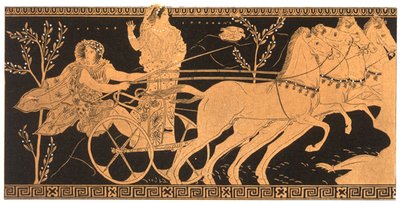Pelops
|
|

| Contents |
Story of Pelops
Pelops’ father was Tantalus, king at Mount Sipylus in Anatolia. Wanting to make an offering to the Olympians, Tantalus cut Pelops into pieces and made his flesh into a stew, then served it to the gods. Demeter, deep in grief after the abduction of her daughter Persephone by Hades, absentmindedly accepted the offering and ate the left shoulder. The other gods however sensed the plot and held off from eating of the boy’s body and brought Pelops back to life, his shoulder replaced with one made of ivory made for him by Hephaestus. After his resurrection, Pelops was more beautiful than before; Poseidon fell in love with him, took him up to Olympus and made the youth his lover, teaching him to drive the divine chariot. Later, Zeus threw Pelops out of Olympus, angry that his father, Tantalus, had stolen the food of the gods, given it to his subjects back on Earth and revealed the secrets of the gods.
Pelops, a man now, wanted to marry Hippodamia. King Oenamaus of Pisa or Olympia, her father, had killed thirteen suitors of Hippodamia after beating them in a chariot race. He did this because he loved her himself or, alternatively, because a prophecy claimed he would be killed by his son in law. Pelops came to ask for her hand, and got ready to race Oenomaus. Worried about losing, he went to the seaside and invoked Poseidon, his old lover. Reminding Poseidon of their love (“Aphrodite’s sweet gifts”) he asked Poseidon for help. Smiling, Poseidon caused a chariot drawn by winged horses to appear. Still unsure of himself, Pelops (or alternatively, Hippodamia herself) convinced Oenomaus' charioteer, Myrtilus, a son of Hermes, (by promising him half of Oenomaus’ kingdom and the first night in bed with Hippodamia), to help him win. The night before the race, while Myrtilus was putting the chariot together, he replaced the bronze linchpins attaching the wheels to the chariot axle with fake ones made of beeswax. The race started, and went on for a long time. But just as Oenomaus was catching up to Pelops and getting ready to kill him too, the wheels flew off and the chariot broke up. Myrtilus survived but Oenomaus was dragged to his death by his horses. Pelops then killed Myrtilus because he had attempted to rape Hippodamia. As Myrtilus died, he cursed Pelops for his betrayal. This was the source of the curse that destroyed his family (two of his sons, Atreus and Thyestes killed a third, Chrysippus, who was his favorite son and was meant to inherit the kingdom; Atreus and Thyestes were banished by him together with Hippodamia, their mother, who then hanged herself) and haunted Pelops' children, grandchildren, and great-grandchildren including Atreus, Thyestes, Agamemnon, Aegisthus, Menelaus and Orestes.
Apocrypha
Pelops soon controlled the entire Peloponnesos (which means “Pelops’s island") and then took Oenomaus's kingdom in Pisa.
During the Trojan War, Pelops's bones were brought to Troy by the Greeks because an oracle claimed they would be able to win by doing so.
Spoken-word myths - audio files
| Pelops myths as told by story tellers |
|---|
| 1. Apotheosis of Pelops, (integral to myth of Tantalus), read by Timothy Carter |
| Bibliography of reconstruction: Homer, Odyssey, 11.567 (7th c. BCE); Pindar, Olympian Odes, 1 (476 BCE); Euripides, Orestes, 12-16 (408 BCE); Apollodorus, Epitomes 2: 1-9 (140 BCE); Ovid, Metamorphoses, VI: 213, 458 (8 CE); Hyginus, Fables, 82: Tantalus; 83: Pelops (1st c. CE); Pausanias, Description of Greece, 2.22.3 (160 - 176 CE) |
| 2. Marriage of Pelops and Hippodameia, read by Timothy Carter |
| Bibliography of reconstruction: Pindar, Olympian Ode, I (476 BCE); Sophocles, (1) Electra, 504 (430 - 415 BCE) & (2) Oenomaus, Fr. 433 (408 BCE); Euripides, Orestes, 1024-1062 (408 BCE); Apollodorus, Epitomes 2, 1-9 (140 BCE); Diodorus Siculus, Histories, 4.73 (1st c. BCE); Hyginus, Fables, 84: Oinomaus; Poetic Astronomy, ii (1st c. CE); Pausanias, Description of Greece, 5.1.3 - 7; 5.13.1; 6.21.9; 8.14.10 - 11 (ca. 160 - 176 CE); Philostratus the Elder Imagines, I.30: Pelops (170 - 245 CE); Philostratus the Younger, Imagines, 9: Pelops (ca. 200 - 245 CE); First Vatican Mythographer, 22: Myrtilus; Atreus et Thyestes; Second Vatican Mythographer, 146: Oenomaus |
| 3. Downfall of Pelops: the Laius and Chrysippus myth, read by Timothy Carter |
| Bibliography of reconstruction: Pindar, Olympian Ode, I (476 BCE); Apollodorus Library and Epitome 3.5.5 (140 BCE); Hyginus, Fables, 85. Chrysippus; 243. Women who Committed Suicide (1st c. CE); Pausanias, Description of Greece, 9.5.5-10, 6.20.7 (c. 160 - 176 CE); Athenaeus, The Deipnosophists, Book XIII, 602 (c. 200 CE); Clement of Alexandria, Exhortation to the Greeks, ii, 34, 3 - 5 (150 - 215 CE) |
Sources
- Ovid, Metamorphoses VI, 403-11
- Apollodorus, Epitome II, 3-9; V, 10
- Pindar, Olympian Ode I
- Sophocles, Electra 504 and Oenomaus Fr. 433
- Euripides, Orestes 1024-1062
- Diodorus Siculus, Histories 4.73
- Hyginus, Fables: 84 - Oenomaus
- Pausanias, Description of Greece 5.1.3-7, 5.13.1, 6.21.9, 8.14.10-11
- Philostratus, Imagines 1.30 - Pelops
- Philostratus the Younger, Imagines 9 - Pelops
- First Vatican Mythographer, 22 Myrtilus, Atreus and Thyestes
- Second Vatican Mythographer, 146 - Oenomaus
External link
- The sacrifice of Pelops, a fully developed story (http://www.haidukpress.com/tantalus/index.html) compiled from selected primary sources to highlight the shamanic and promethean aspects of the tale. By Pindar's time this view would have been rejected.de:Pelops
et:Pelops fr:Pélops it:Pelope nl:Pelops pl:Pelops pt:Pélope sv:Pelops uk:Пелоп he:פלופס
